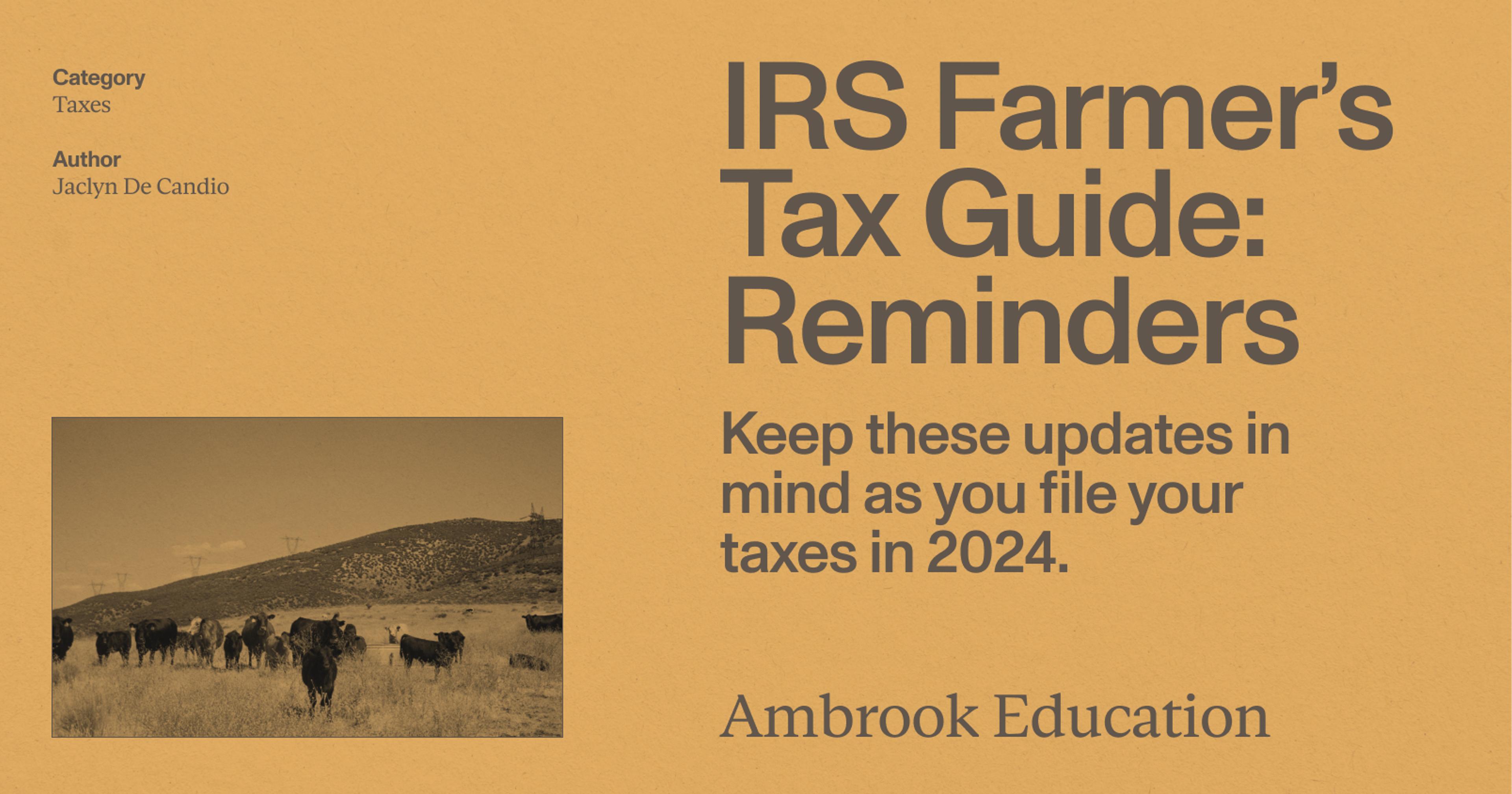Keep these updates in mind as you file your taxes for 2024
We often think of tax season as being an annual occurrence, but in reality, proper preparation is a year-round pursuit – especially for businesses with heavy cash flow like agriculture. By taking steps now to organize and update your records, you can make the process much smoother when it’s time to file your farm tax returns.
Tax laws and regulations are not static. You need to keep on top of changes, not just to avoid potential penalties, but to capitalize on opportunities for tax credits and deductions. A good tax strategy plays a major role in dictating farm profitability.
A good starting point is to periodically review your financial situation, ensuring that your records are up-to-date and correct. This practice also presents an opportunity to stay ahead of any new tax regulations that may affect your filing.
To start, become familiar with Publication 225, the Farmer’s Tax Guide published by the Internal Revenue Service (IRS). The IRS has a page on its website for future developments affecting IRS Publication 225. It includes other important information on taxable and nontaxable income, travel and car expenses, accounting periods and methods, passive activity, and at-risk rules.
New for 2024
Though there is not much new for this tax year, you should pay attention to the changes that go into effect this year as they may affect your business.
Social Security and Medicare tax: This year, the IRS has published the Employer’s Tax Guide (IRS Publication 15), which can be used by all employers, including agriculture employers. This replaces the discontinued IRS Publication 51.
The rate of Social Security tax on taxable wages for 2024 is 6.2% each for employer and employee. The Social Security wage base limit is $168,600. The Medicare tax rate is 1.45% each for the employee and employer, unchanged from 2023. Keep in mind there is no limit on the amount of wages subject to Medicare ta
Social Security and Medicare taxes apply to the wages of household workers paid $2,700 or more in 2024.
Withholding tables: The percentage method and wage bracket method withholding tables and instructions on figuring withholding are now included in IRS Publication 15-T. The publication also includes amounts to be added to the wages of non-resident alien employees
Phase down of special depreciation allowance: The special depreciation allowance for farmers is a tax provision and allows the deduction of a significant portion of the cost of qualifying agricultural property in the year it is placed in service, rather than spreading the deduction over the property’s useful life.
The phase-down for this allowance means that for certain farm property acquired after September 27, 2017, and placed in service after December 31, 2024 and before January 1, the immediate depreciation deduction will be 40% (or 60% for specific long-production-period property and aircraft) instead of the previously higher rates.
The special depreciation allowance is 40% for certain plants bearing fruits and nuts planted or grafted after December 31, 2024, and before January 1, 2026.
You can elect to not deduct the special depreciation allowance for property placed in service in 2024 as well. Attach a statement to your return indicating the class of property for which you are making the election.
Remember that when you dispose of a property for which you claimed a special depreciation allowance, any gain is generally recaptured as ordinary income up to the allowance amount.
Section 179 deduction: The maximum section 179 expense deduction for tax years beginning in 2024 is now $1,220,000. This deduction is reduced dollar-for-dollar by the amount that the total cost of Section 179 property exceeds $3,050,000. The deduction for sport utility vehicles placed in service in 2024 is $30,50
Credit for COVID-related sick and family leave wages: In the rare case that you pay qualified sick and family leave wages in 2024 for leave taken after March 31, 2020, and before October 1, 2021, you are eligible to claim a credit for qualified sick and family leave wages in 2024. You will have to file Form 941-X because lines for the credit have been removed from Form 941 for tax periods after December 31, 2023.
Bookkeeping best practices
Regardless of the year, bookkeeping best practices and habits are wise to follow at any time:
Start every year with a clean slate by reconciling all records from the previous year
Regularly double-check your statements and books to ensure they match external statements
If you’re using an accounting software program, check that you have accurately categorized your income and expenses
Get an early start on your profit and loss statements and cash flow statements
Go through receipt files to ensure they are being collected and organized
Touch base with team members to ensure they are following your accounting process and provide a refresher if necessary
Tax Deductions
As business owners, farmers are eligible for both tax deductions and tax credits. Keep in mind that deductions are a strategy for reducing tax burden. They are applied to gross income before the taxes are calculated. Credits are a strategy to reduce taxes. They are applied to a tax burden to increase a refund or reduce taxes due.
Farmers may claim several different tax credits, including:
Fuel tax credits
Renewable energy credits
Research and development credits
State tax credits
Earned income tax credits for farmers with low income
Deductions include the more obvious expenses, like interest on loans, repairs and maintenance, and inputs, and less obvious expenses like investments in conservation practices. You can deduct soil and water conservation expenses only if they are consistent with a plan approved by the Natural Resources Conservation Service
The Farmer’s Tax Guide is a good place to start learning about deductions and credits and options that may be available to you. It is also useful to start a conversation with a tax planner on strategies that can help you make farm improvements and get tax credits for doing so.
Stay organized year-round
A good farm bookkeeping system goes far beyond filing taxes. Records can help you establish relevant benchmarks, measure progress, set goals, apply for grants and loans, and manage risk.
While bookkeeping options are as varied as the individual, the best methods are those that can be maintained. Establish a protocol that works for you and stick to it.
Set reminders on your calendar for important tax deadlines and stay on top of new tax laws and regulations for employees
Even if you hire a bookkeeper or a tax accountant to keep your records and file taxes, you should be familiar with your tax return. Review Schedule F (Form 1040), for reporting business profit or loss, and Form 4797, for reporting sales of farm assets like land, buildings and structures, equipment, and breeding stock.
Beyond tax year 2024
Few businesses rival farms in the complexity of their tax forms. Depreciation, indemnity payments, market gains, patronage dividends, income averaging, passive activity limits, and more are enough to make your head spin. A good accountant or tax professional who can help you navigate taxes paired with an effective farm accounting system is worth their weight in gold.
This resource is provided for general informational purposes only. It does not constitute professional tax, legal, or accounting advice. The information may not apply to your specific situation. Please consult with a qualified tax professional regarding your individual circumstances before making any tax-related decisions.






